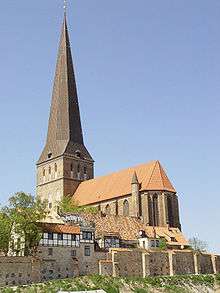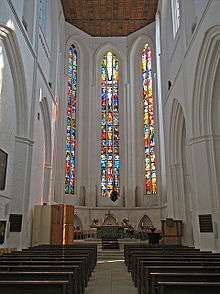St. Peter's Church, Rostock
St. Peter's Church, in German Petrikirche, is the oldest of three town churches found in the Hanseatic city of Rostock, in northern Germany. The other two are St. Mary's Church (Marienkirche) and St. Nicholas (Nikolaikirche). A fourth, St. Jakobi, was heavily damaged during the Second World War and subsequently demolished.

Building
St. Peter's Church was built in the middle of the 14th century. The first reference to a church on this site is in 1252, which is thought to be the predecessor of the current building. The triple-nave basilica is in Brick Gothic, a building style typical of the Hanseatic port cities of northern Germany.
Damage
The pre-existing church had a tower 127m (413 feet) high which was destroyed by a thunderbolt in 1543. In 1578 the tower was rebuilt as a polygonal spire after it had been, once again, damaged by storm. With a height of 117m (380 feet) the tower served as a familiar landmark in the local area. In the following centuries the church decayed and in 1902 the Basilica was renovated. Forty years later, however, heavy bombing during World War II again damaged the church and led to the collapse of the polygonal spire.

Re-building
Following the war, the building was gradually rebuilt. Today the church, roofed by a flat timber ceiling, reaches a height of 24m (78 feet) and in 1994 a glass window in the choir was built to a height of 17m (55 feet). Public donations funded the building of a copper polygonal spire and this allowed St. Peter's to once again become a visible landmark in the surrounding area. Additionally, a 45m (146 feet) observation platform (accessed via steps and an elevator) provides fine views of the city of Rostock and the Baltic Sea.
Description

The church is a three-nave Basilica with a high cross-vaulted ceiling in the west tower. On the north and south façade 4 times over are ever-alternating round arched arcades each with a large rectangular window. in the central aisle of the tower 3 high round arched arcades are on each side except the eastern side, where the tower joins the Basilica, at each of the four points there are 3 round-arched windows. The choir section is polygonal; at the north and south end is one small fiale with a pointed tip. The design of the dividing inner-wall (zweizonige) exhibits the round-arched arcade design typical of Roman-Gothic style. Prior to World War II damage, the arched gallery was open. However, it was only roughly rebuilt when reconstruction began. The light coming in from the large rectangular windows, flows over the gallery. The cross-ribbed vaulted ceiling that covers the northern end of the nave is preserved. However, the southern nave was too badly damaged to reconstruct the original. Also, the central nave couldn’t be restored, so instead a flat-timbered ceiling was put in place. The baroque decoration in the interior of the church was destroyed by fire during the World War II bombing of Rostock on the night of 26th and 27 April 1942. The stained glass windows of the choir are decorated with scenes from the life of St. Peter and were designed in the early 60s by local artist Lothar Mannewitz (1930–2004).
| Wikimedia Commons has media related to St. Petrikirche. |
Coordinates: 54°05′26″N 12°08′53″E / 54.09056°N 12.14806°E